The shadow pattern scheme in knitting is popular among modern needlewomen. Using this technique, you can decorate any outfit, having only 1 color of yarn.
What are shadow patterns and what products are they used in?
Scientists have established that knitting has been known to man for a long time. The first knitted items were found by archaeologists in Peru, and the time of their creation is considered to be the 3rd century.
Shadow knitting pattern, the scheme of which will help to understand all the subtleties of the creative process, is suitable for decorating knitted items for children and adults. In this way, needlewomen create interior details or bedding often used in everyday life, for example, blankets.
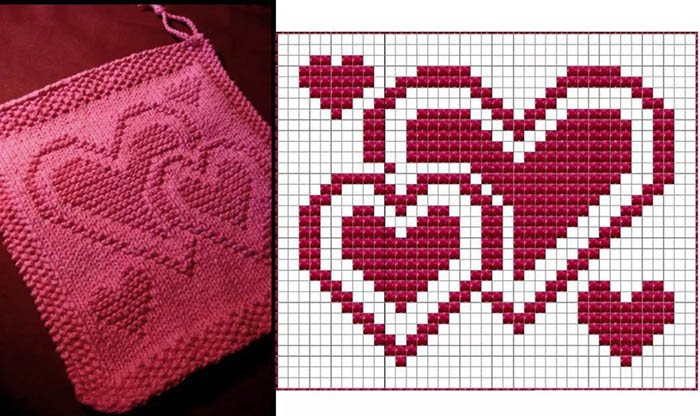
Knitting is a method of interlacing threads by hand using knitting needles, a needle, or a crochet hook.
The main loops with which craftswomen create various patterns are:
- facial;
- purl;
- edge;
- removed;
- yarn over.
Having learned to understand them, a beginner needlewoman will quickly understand how to create masterpieces from yarn of any density and for any occasion. She will also master the shadow pattern, as this is a way of alternating front and back loops in a certain order, taking into account the rows and sides of the fabric.
Some call shadow knitting "knitting with needles", since the patterns for it are also suitable for those offered to needlewomen who embroider with a cross. Historians have not been able to clarify where and how this method of interlacing threads first appeared. This is due to the fact that various methods of creating warm and everyday things are found in the culture of many peoples.

For example, in ancient Egyptian burials, archaeologists found 2-toe socks, which allowed wearing flip-flops even in cold weather. The product has been well preserved to this day and can now be seen in the Egyptian Museum.
In one of the churches there is an altar where the Virgin Mary is depicted knitting, which also indicates that this type of handicraft has been known to people for a long time, and its skills have been passed down from generation to generation.
Experts are sure that shadow knitting appeared during the period of the appearance of the front and back loops. Not yet able to create complex patterns on clothes, the first craftswomen tried to diversify their products in this way.
On modern clothing, knitting needles can be found on:
- children's things;
- sweaters;
- vests;
- mittens and gloves;
- scarves;
- hats;
- cardigans;
- capes.
The technique of making a pattern from threads on a knitted item is simple, so even a beginner needlewoman can handle it. Due to the fact that patterns created using knitting needles are not conspicuous, they are also liked by the opposite sex. They can often be seen on men's jumpers, vests or dressing gowns.
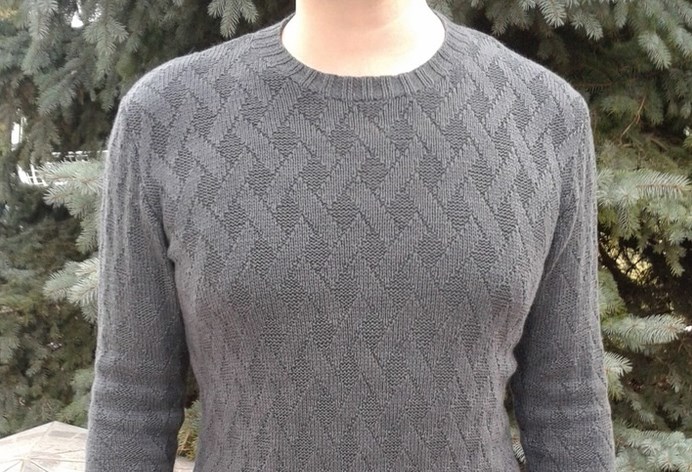
Do not confuse shadow knitting with illusion knitting, which appeared relatively recently and is recognized as a special kind of art. In this case, the pattern on the canvas is visible only at an angle, and if you look at the thing directly, it will not attract attention in any way. In addition, illusion knitting requires 2 or more colors of threads, which also makes it different from shadow knitting.
Shadow knitting has its advantages.
These include:
- Ease of operation.
- Speed of creating things.
- Ease of forming an idea.
- Versatility.
- Saving consumables.
Working with front and back loops is simple and fast. There are no complicated patterns or incomprehensible symbols that need to be looked up, which saves time. In addition, it is easier and faster to create a thing decorated with a shadow pattern than with other ornaments.
The versatility of shadow knitting is that it is suitable for both women's and men's clothing. It is also used to decorate shawls, blankets, bedspreads and napkins. The knitting method allows you to save paper on drawing a pattern. This is due to the method of applying and reading symbols.
In addition, a product decorated with a pattern "embroidered" with knitting needles looks good in any color and on any thickness of threads. You can create a unique thing from any yarn at hand, without spending money on an unplanned purchase.
Master class on knitting shadow patterns with diagrams
A shadow knitting pattern, the scheme of which can attract the attention of a needlewoman, is made from any yarn you like. Such masterpieces are knitted on separate or circular knitting needles with single-color or multi-colored threads.
Before you begin creating your first piece of shadow stitch, You need to know the symbols that appear on the diagrams and be able to read them.
| Abbreviated name | Full meaning |
| lp | face loop |
| ip | purl stitch |
| nak. | yarn over |
| kr. | edge |
Also, the front loop is designated by "X", "P" or "+", and the back loop - by "-", "K" or "Ո". In the schemes of shadow patterns, loops are often highlighted in color. For example, the convex part of the pattern can be painted black, blue or red, and the parts where regular knitting is used - white.
When reading a knitting pattern, you need to understand that the front loops are always the main component of the fabric, and the back loops make the pattern. The pattern becomes three-dimensional and is visible from both sides.
The trick of shadow pattern schemes is that they encode knitting of 2 rows at once. When looking at such an image, you need to understand that 1 cell is 1 loop in 2 rows at once. Experienced craftsmen recommend starting to create a pattern on yarn from the back row, since the entire main pattern is knitted only with K-loops.
Geometric patterns look best on knitted fabric, so the following are most common:
- zigzags;
- circles;
- rectangles;
- diamonds;
- triangles.

More complex designs using simple figures are also found on knitted items.
Popular are:
- angel;
- star;
- snake;
- crown;
- network;
- heart;
- snowflake.
To create a voluminous fabric, use thick yarn and thin knitting needles, and for a looser openwork knitting, use thick knitting needles and thin threads.
Rhombuses
In order to decorate the canvas with diamonds obtained by the shadow knitting method, you need to prepare yarn and knitting needles. The selected geometric figure can be either single, or consist of a pair, or be inscribed one into another.
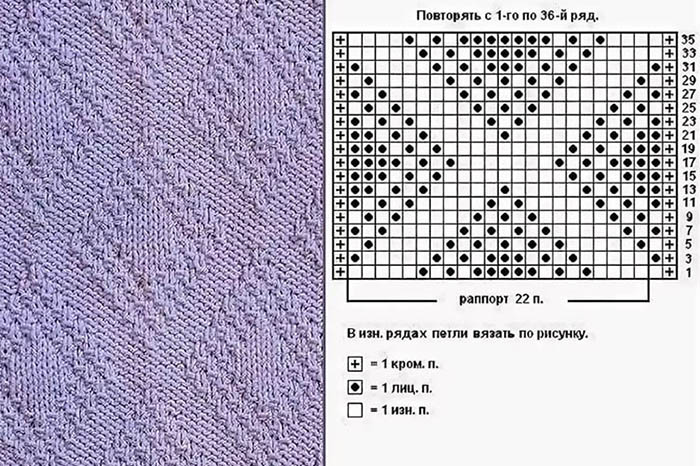
To get a canvas consisting of shadow diamonds, you need:
- Cast on 17 stitches (including 2 edge stitches).
- Knit row 1.
- Start with row 2 to create a shadow pattern. To do this, knit 7 knit stitches after the edge stitch, a purl stitch, 7 knit stitches and an edge stitch.
- Knit row 3 and the remaining odd rows according to the pattern.
- Start row 4 with edge stitch, then purl, 5 knit stitches, purl, knit, purl, 3 knit stitches and edge stitch.
- Work with edge stitches in each row.
- Knit row 5 knit, purl, 3 knit, purl, 3 knit, purl, 2 knit.
- Row 7: knit 2 stitches, purl, knit, purl, 5 stitches, purl and knit.
- Knit row 9 3 knit, purl, 7 knit, purl,
- Knit row 11 with 2 knit stitches, purl stitch, knit stitch, purl stitch, 5 knit stitches, purl stitch and knit stitch.
- Row 13: knit, purl, 3 knits, purl, 3 knits, purl and 2 knits.
- Knit row 15 purl, 5 knit, purl, knit, purl and 3 knit.
At the end of the work, the loops of the fabric are closed.
Network
"Pletyonka" is another popular pattern of shadow knitting. It is used to decorate pillows, blankets, bedspreads, belts and, sometimes, shoes. As the name suggests, the pattern is formed by a special interweaving of threads and stripes. The more loops the pattern contains, the wider the ornament will be.
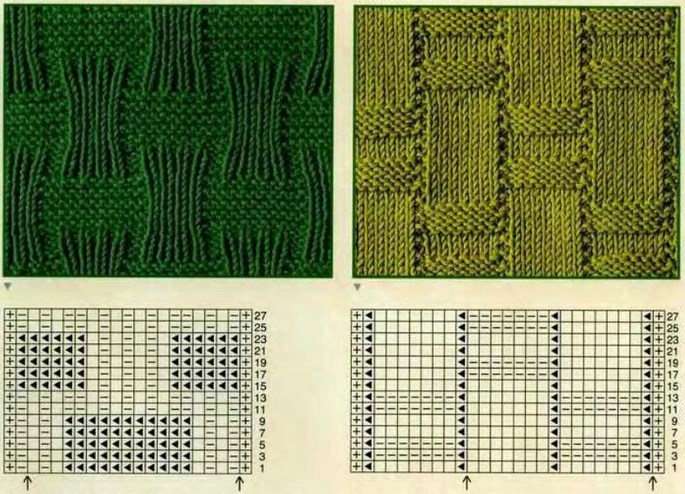
To work you will need yarn and 3 knitting needles.
To knit a product with a braided pattern, you need:
- Cast on 8 stitches on the needle.
- Knit row 1, slipping the edge stitch, transfer 2 stitches to an additional knitting needle and leave at the front of the row, 2 knit stitches, 2 spare knit stitches, edge stitch. Work on the edge stitches occurs in each row.
- Knit rows 2, 4, 6 with purl stitches.
- Knit row 3 with 2 front stitches, 2 on an additional knitting needle in reserve behind the work, 2 front stitches, knit 2 front stitches from reserve as front stitches.
- Work row 5 as row 1.
At the end of knitting, the loops are closed. The pattern rapport is repeated in the planned number of rows.
Zigzag
Externally, the "Zigzag" pattern resembles waves with sharp peaks. Any product is decorated with such an ornament, made using the shadow knitting method.
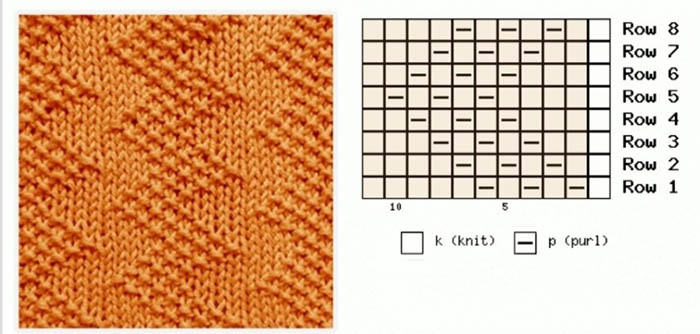
To create waves from yarn on fabric, you need:
- Cast on 42 stitches (32 main stitches, 2 edge stitches and 8 for symmetry).
- In row 1, knit 10 knit stitches, 2 ip, 2 knit stitches, 2 ip. Repeat the pattern from 10 to 2, then knit 8 knit stitches at the end of the row.
- Knit rows 2, 4, 6, 8, 10 and the rest of the even ones according to the pattern.
- Row 3: knit 8, 2 knits, 2 knits, 2 knits, 2 knits (repeat from 8 to 2). At the end of the row, knit 8 purl stitches.
- Knit row 5 6th knit stitch, 2 ip, 2 knit stitch, 2 ip, 2 knit stitch (rep from 6 to 2). At the end of the row, knit 6 knit stitches and 2 purl stitches.
- In row 7, knit 4 ip, 2 kp, 2 ip, 2 kp, 6 ip (repair from 4 to 6). Finish the row with 4 ip, 2 kp and 2 ip.
- Knit row 9 2 knits, 2 ip, 2 knits, 2 ip, 8 knits (repeat from 2 to 8). The end of the row consists of 2 knits, 2 ip, 2 knits and 2 ip.
- Form row 11 from 2 knits, 2 ips, 2 knits, 10 ips (repair from 2 to 10). End the row with 2 knits, 2 ips, 2 knits, 2 ips.
- Knit in row 13 2 knit stitches, 2 ip, 10 knit stitches, 2 ip (repeat from 2 to 2). Form the end of the row 2 knit stitches, 2 ip, 4 knit stitches.
- In row 15, knit 2 knit stitches, 10 ip, 2 knit stitches, 2 ip (rep from 2 to 2). At the end of the row, there should be 2 knit stitches and 6 ip.
- Knit the remaining rows, repeating the pattern from row 1.
At the end of the work, the loops are closed.
Triangles
The scheme of the shadow pattern with knitting needles may contain recommendations for knitting a pattern of triangles. The ornament on the canvas looks the same on 2 sides. To create a pattern using "embroidery" with knitting needles, you will need a skein of nikto and 2 separate knitting needles.
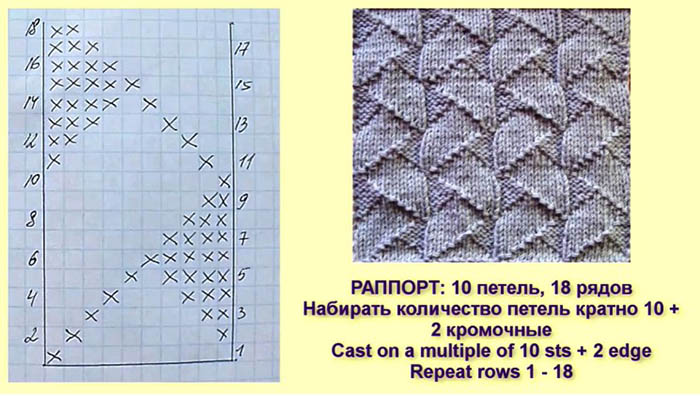
To get the "Triangles" pattern, you need:
- Cast on 30 stitches.
- Knit a row of 1 edge stitch, 6 ip, 1 knit stitch. Repeat the entire row, and make the last stitch a purl stitch.
- In all subsequent rows, the initial edge stitch is removed and the last one is knitted purlwise.
- Knit row 2, alternating 2 ip and 5 kp.
- In row 3 there should be an alternation of 4 ip and 3 lp.
- Knit row 4 as 3.
- Knit row 5 as 2.
- Repeat pattern 1 in row 6.
At the end of the work, the loops are closed.
Snake
The pattern of the same name resembles a snake crawling on the surface, which works well in the shadow knitting technique. Experts note that in needlework there are many ornaments called "Snake". For example, some have dubbed "Zigzag" this way.
To knit you need a skein of thread, 2 knitting needles that are not connected to each other and a large pin for spare loops.

To get the snake, you need to:
- Cast on the required number of stitches on the knitting needles.
- Knit row 1 4 ip, slip 2 loops onto a pin behind the work, 2 knit stitches, knit the 2 set aside stitches. 4 ip.
- Row 2 consists of 2 stitches slipped on a pin behind work, 2 ip, 2 set aside as purl, 4 kn, 2 stitches slipped on a pin behind work, 2 ip and 2 set aside as purl.
- Knit row 3 4 ip, leave 2 loops in front of work, 2 knit stitches, 2 set aside as front loops, 4 ip.
- Row 4 consists of 2 stitches, slipped before work, 2 ip, 2 set aside – purl, 4 knit stitches, 2 slipped before work, 2 ip and 2 set aside – purl.
- Knit row 5 as row 1.
- Row 6 knit as row 2.
- Knit row 7 as row 3.
- Repeat row 4 pattern in row 8.
The rows are repeated as many times as necessary to form a whole piece of the desired length.
Squares
The shadow pattern "Squares" resembles a chessboard, only the cells on it are highlighted not by color, but by the play of light. This ornament looks good on scarves, hats, golfs and other knitted items.
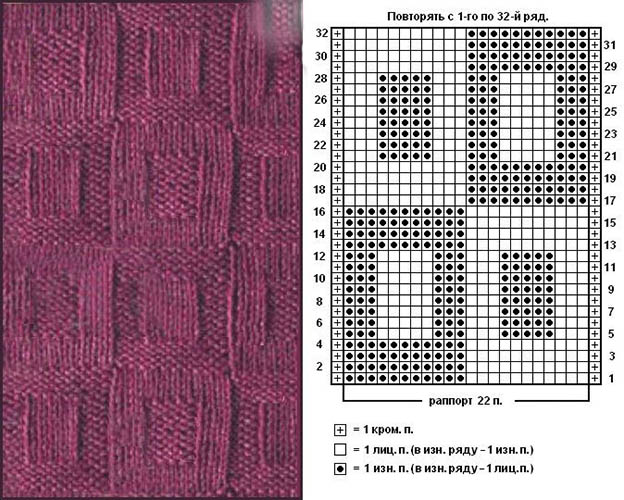
To create squares you will need yarn and 2 separate knitting needles.
To get a simple pattern you need:
- Cast on an even number of stitches, including 2 edge stitches.
- Knit rows 1, 3 and 5 alternating 4 ip and 4 lp.
- Knit all even rows according to the pattern.
- Knit rows 7, 9 and 11 alternating 4 knit stitches and 4 ip stitches.
- The pattern is repeated every 6 rows.
At the end of the work, the loops are closed. In the pattern, you can also alternate large and small squares. To do this, you need to reduce the number of loops in all even or odd figures. For example, where there were 4 ip on 4 lp, you can make 4 ip on 2 lp.
Star
The "Star" pattern looks interesting on the canvas. It is placed on hats, mittens or blankets.
To get a shadow pattern, you need:
- Cast on 21 stitches.
- Knit row 1, alternating 3 knit stitches, 2 ip, 11 knit stitches, 2 ip, 3 knit stitches.
- All even rows are knitted according to the pattern.
- Row 3 consists of alternating 3 knits, 3 purl, 9 knits, 3 purl and 3 knits.
- Knit row 5, alternating 3 knit stitches, 4 ip, 7 knit stitches, 4 ip and 3 knit stitches.
- Row 7 consists of alternating 4 knits, 4 purl, 5 knits, 4 purl and 4 knits.
- Knit row 9, alternating 4 knit stitches, 5 ip, 3 knit stitches, 5 ip and 4 knit stitches.
- Row 11 consists of alternating 4 knits, 6 sl sts, 1 knit, 6 sl sts and 4 knits.
- Knit rows 13, 17 and 19, alternating 5 knit stitches, 11 ip and 5 knit stitches.
- Row 21 consists of alternating 4 LP, 13 IPS and 4 LP.
- Knit row 23, alternating 3 knit stitches, 15 ip and 3 knit stitches.
- Row 25 consists of alternating 2 knits, 17 sl sts and 2 knits.
- Knit row 27, alternating 1 knit stitch, 19 ip and 1 knit stitch.
- Row 29 – all purl.
- Knit row 31, alternating 7 knit stitches, 7 ip stitches and 7 knit stitches.
- Rows 33, 35 and 37 consist of alternating 8 knits, 5 purl and 8 knits.
- Knit rows 39, 41 and 43, alternating 9 knit stitches, 3 ip and 9 knit stitches.
- Rows 45, 47 and 49 consist of alternating 10 knits, 1 purl and 10 knits.
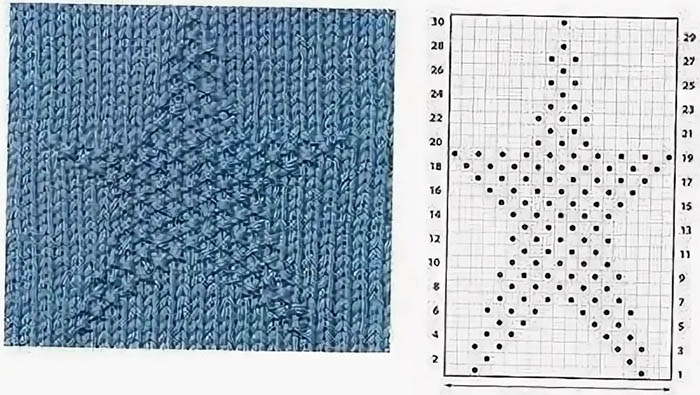
Having received the star, all loops are closed in any convenient way.
Angel
The shadow knitting pattern, the scheme of which is now popular among needlewomen, is called "Angel". Silhouettes of these mythical creatures are usually used to decorate children's things.
To create an angel on a canvas from yarn, you need:
- Cast on 17 stitches.
- Knit the row before the pattern and after with knit stitches.
- Row 1 is formed from alternating 6 knit stitches, 3 purl stitches and 6 knit stitches.
- Rows 2, 4, 6 and other even rows are knitted according to the pattern.
- Knit row 3, alternating 4 knit stitches, 7 ip and 4 knit stitches.
- Rows 5, 7 and 9 are formed from 2 knit stitches, 11 ip and 2 knit stitches.
- Knit row 11, alternating 3 knit stitches, 9 ip and 3 knit stitches.
- Row 13 is obtained by knitting 4 LP, 7 ip and 4 LP.
- Knit row 15, alternating 2 knit stitches, 1 ip, 2 knit stitches, 5 ip, 2 knit stitches, 1 ip and 2 knit stitches.
- Row 17 is obtained by knitting 1 knit stitch, 1 ip, 1 knit stitch, 2 ip, 1 knit stitch, 3 ip, 1 knit stitch, 2 ip, 1 knit stitch, 1 ip and 1 knit stitch.
- Knit row 19, alternating 1 knit stitch, 1 ip, 3 knit stitches, 5 ip, 3 knit stitches, 1 ip, 1 knit stitch.
- Row 21 is obtained by knitting 1 lp, 1 ip, 4 lp, 3 ip, 4 lp, 1 ip and 1 lp.
- Knit row 23, alternating 2 knits, 1 ip, 2 knits, 1 ip, 3 knits, 1 ip, 2 knits, 1 ip and 1 knit.
- Row 25 is obtained by knitting 3 LP, 2 IPS, 1 LP, 1 IPS, 1 LP, 1 IPS, 1 LP, 2 IPS and 3 LP.
- In row 27 create 7 lp, 1 ip and 7 lp.
At the end of the work, the loops are closed in any convenient way.
Snowflake
Knitted fabric can be decorated using the technique of "Embroidery with needles" with a shadow pattern "Snowflake". It is often found on clothes, both for children and adults.

To get a snow ornament, you need:
- Cast on 17 stitches (including edge stitches).
- The first and last rows, let's call them "zero", are knitted purlwise.
- Rows 1 and 25 are formed from 5 ip, 2 kp, 3 ip, 2 kp and 5 ip.
- Knit all even rows according to the pattern.
- Rows 3, 5, 21 and 23 are formed from 5 ip, 3 kn, 1 ip, 3 kn and 5 ip.
- Knit rows 7 and 19, alternating 1 ip, 4 kp, 1 ip, 2 kp, 1 ip, 2 kp, 1 ip, 4 kp and 1 ip.
- Rows 9 and 17 are formed from 2 ip, 4 kp, 1 ip, 1 kp, 1 ip, 1 kp, 1 ip, 4 kp, 2 ip.
- Knit rows 11 and 15, alternating 3 ip, 4 kp, 1 ip, 1 kp, 1 ip, 4 kp, 3 ip.
- Row 13 consists of 7 ip, 3 lp and 7 ip.
The snowflake is ready and the loops can be closed.
Heart
It is not difficult to knit the “Heart” pattern on the product. It also consists of alternating front and back loops, and is knitted using the shadow method.

To get a heart on the canvas, you need:
- Cast on 19 stitches.
- Knit the first and last rows (let's call them "zero") with knit stitches.
- Knit row 1, alternating 8 knit stitches, 1 ip and 8 knit stitches.
- Knit all even rows according to the pattern.
- Row 3 consists of 6 LP, 3 IPS and 6 LP.
- Knit row 5, alternating 5 knit stitches, 5 ip stitches and 5 knit stitches.
- Row 7 consists of 4 knits, 7 sl sts and 4 knits.
- Knit row 9, alternating 3 knit stitches, 9 ip and 3 knit stitches.
- Row 11 consists of 2 knits, 11 sl sts and 2 knits.
- Knit row 13, alternating 1 knit stitch, 13 ip and 1 ip.
- Rows 15, 17 and 19 are formed entirely from purl stitches.
- Knit row 21, alternating 1 knit stitch, 7 ip, 1 knit stitch, 7 ip and 1 knit stitch.
- Row 23 consists of 1 knit, 6 sl st, 3 knit, 6 sl st and 1 knit.
- Knit row 25, alternating 2 knit stitches, 4 ip, 5 knit stitches, 4 ip and 2 knit stitches.
The loops of the fabric with the finished heart can be closed.
Crown
You can decorate your hat or your child's hat with the "Crown" pattern, using the shadow knitting technique.
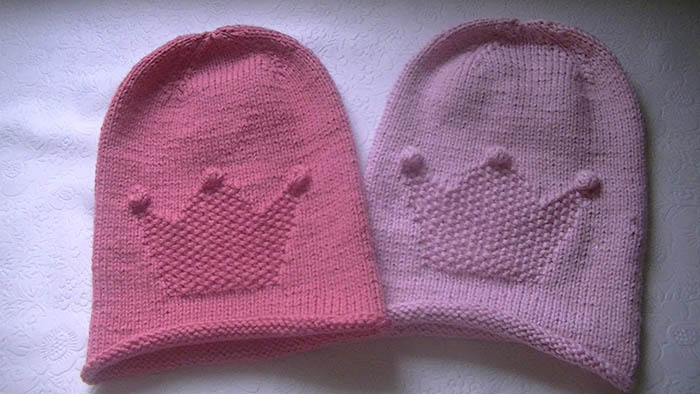
To create a pattern you need:
- Cast on 26 stitches (including edge stitches).
- Knit rows 1, 3 and 5, alternating 5 knit stitches, 14 purl stitches and 5 knit stitches.
- Form all even rows according to the pattern.
- Knit rows 7, 9 and 11, alternating 4 knit stitches, 16 sl sts and 4 knit stitches.
- Form rows 13 and 15 from 3 LP, 18 ip and 3 LP.
- Knit row 17, alternating 2 knit stitches, 5 ip, 1 knit stitch, 8 ip, 1 knit stitch, 5 ip and 2 knit stitches.
- Form row 19 of 1 knit, 4 ip, 4 knit, 6 ip, 4 knit, 4 ip and 1 knit.
- Knit row 21, alternating 4 ip, 5 kp, 6 ip, 5 kp and 4 ip.
- Form row 23 of 4 ip, 6 lp, 4 ip, 6 lp and 4 ip.
- Knit row 25 1 knit, 2 ip, 7 knit, 4 knit, 7 knit, 2 ip and 1 knit.
- Make rows 27 and 33 of 22 LP, 2 ip and 22 LP.
- Form rows 29 and 31, alternating 20 LP, 4 ip and 20 LP.
The Crown pattern is ready, the work can be closed.
Practical Application of Shadow Patterns
A shadow knitting pattern, the scheme of which fell into the hands of an experienced needlewoman, can develop into a knitted masterpiece. Ornaments obtained by interlacing front and back threads have been known to craftswomen of many nations for several centuries and they still have not lost their popularity.
The knitting pattern of the shadow pattern can be applied to any knitted item from the wardrobe. Skirts, scarves, gloves, snoods and capes look beautiful with such elements. By turning on your imagination, with the help of knitting needles and threads, you can create a truly unique thing and not be afraid that a friend or colleague will appear next to you in exactly the same one.
Video about knitting shadow patterns
Shadow knitting: master class and selection of ideas:
